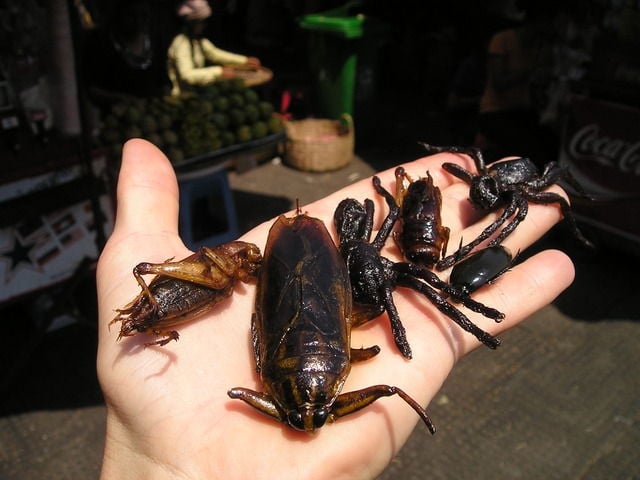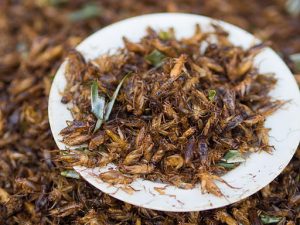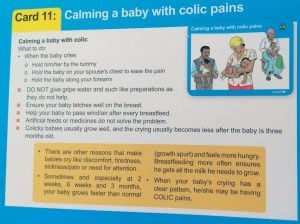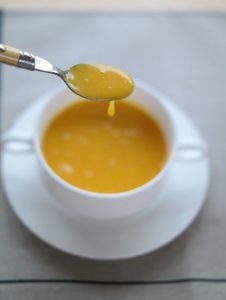The world is gearing up for a rapid rise in population in the coming decades. The current numbers stand at around 7.3 billion and this is expected to spiral up to 9.7 billion by the year 2050 according to a United Nations report.
This presents a major challenge with regards to sustainability and one of the major challenges is how the world is going to cope with feeding this massive population; and not just any feeding, but safe, environmentally friendly and nutritious food.
It’s for this reason that FAO, the agricultural arm of the UN, is promoting the inclusion of edible insects in our diets as a sustainable way of feeding this population and ensuring food and even feed security.
Some have however argued that rearing insects by feeding them the same feed we give poultry and other livestock is not sustainable and makes little difference.
Eating Edible Insects
Still, insects are not exactly popular as foods. They gross out people, scare others to death, not to mention some of their habitats are enough to dismiss their suitability for food.
Nevertheless, while this may be the popular view in most parts, edible insects are by no means strangers to every region in the world. Edible insects are a common feature in most parts of Africa and Asia and it is not uncommon to find them being sold in some markets.
While that may not be the case in Kenya, that is the market part, I think some of us can attest to eating insects at some point. The writers of this blog indeed have, the insect in question being the Termite.
Growing up we would gather them up during the rainy season and have them fried at home and if we’re unfortunately stuck in school, eating them raw wasn’t all that uncommon.
Certainly, as kids then we didn’t realize their nutritional benefits, and we were just as excited to catch them in the air or unearth them from the ground as much as we loved feasting on them.
Nutritional Benefits of Eating Edible Insects

1. Protein Rich
Edible insects are high in protein and can provide inexpensive, quality dietary protein when the usual sources like beef or chicken are inaccessible.
For example, 100g (fresh weight) of adult termites can provide between 13 to 28g of protein. For the same amount, raw beef provides a protein content of between 19 to 26g signifying how protein rich insects can be.1
2. Essential Fats
Edible insects are a source of good oils that are rich in polyunsaturated fatty acids and often contain essential linoleic and alpha-linolenic acids which the body can’t make.1
This fatty acids form the building blocks for Omega-3 and Omega-6 fatty acids which are especially important for the healthy growth and development of infants and young children.
Edible insects can therefore be used to provide some of these fats especially to children in landlocked countries who typically don’t eat fish which are a good source of these fats.
3. Minerals
Most edible insects are rich sources of iron, an important mineral which is required in sufficient amounts to prevent the most common nutrient deficiency in the world, iron deficiency, which if not checked causes the most common form of anaemia called iron deficiency anaemia.
In some cases, the iron content of some insects is equal or even higher than that of beef. Edible insects can therefore be used as good sources of iron, especially to young children and women of child bearing age in developing countries who are at most risk of iron deficiency.
Other than iron, edible insects are also considered to be good sources of Zinc which is important for a healthy immune system.1
4. Vitamins
Most edible insects have vitamins such as Vitamin B1 (thiamine) and B2 (riboflavin) that are essential for the normal functioning of many body processes.1
5. Fibre
The hard outer shell of most insects called the exoskeleton is made up of Chitin, an insoluble fibre which is like the cellulose found in plants. This may act as dietary fibre which is important for a healthy digestive system.
Chitin has also been shown to provide defence against parasitic infections and some allergic conditions.1
Examples of Edible Insects
Some common insects that are consumed in different parts of the world include:
1. Termites
2. Edible Grasshopper, Nsenene
3. Locusts
4. Crickets
5. Ants
- Leaf-cutter ants
- Honeypot ants
- Carpenter ants
6. Caterpillars
- Mopane Caterpillars – popular in sub-Saharan Africa especially in the DRC.
- Witchetty grubs – consumed in Australia
- Bamboo Caterpillar – popular in Thailand and Laos
7. Palm Weevils
8. Stink Bugs
9. Bee, Bee Larvae
10. Wasps
11. Beetles
12. Dragonflies
You can find an exhaustive list here.
References
1. FAO. 2013. Edible Insects: Future Prospects for Food and Feed security (Available at: http://www.fao.org/docrep/018/i3253e/i3253e00.htm)





